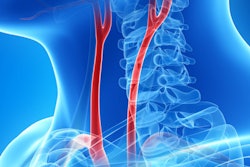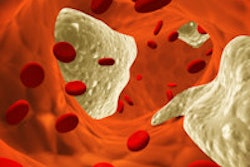Carotid intima-media thickness (CIMT) measured on ultrasound can identify asymptomatic cardiovascular disease in most middle-aged women considered to be low-risk by traditional risk assessment tools, Arizona researchers have found.
In their study, ultrasound-determined CIMT detected subclinical atherosclerosis in more than 60% of asymptomatic middle-aged women with one cardiovascular risk factor and low Framingham risk scores. What's more, CIMT outperformed CT coronary artery calcium scoring (CACS), according to the group from the University of Arizona College of Medicine and the Mayo Clinic College of Medicine in Arizona.
The researchers shared their findings in an article published online August 1 in the Journal of the American Society of Echocardiography.
"Our results suggest that CIMT may be a more sensitive method for [cardiovascular] risk assessment than CACS or traditional risk tools in this population," wrote lead author Dr. Ranjini Roy and colleagues.
Risk assessment shortcomings
More than 56% of adult women in the U.S. will develop clinical cardiovascular disease, which remains the leading cause of death. However, current assessment tools such as the Framingham risk score and Reynolds risk score classify most middle-aged women as low risk. While CIMT and plaque detection on ultrasound as well as CACS have been shown to add incremental predictive value to traditional risk factors, the correlation between the two methods is weak, according to the researchers.
As a result, the group set out to compare the utility of CACS and carotid ultrasound in identifying advanced subclinical atherosclerosis in middle-aged women with at least one cardiovascular risk factor as well as a low Framingham risk score. Asymptomatic women ages 50 to 65 who were referred by primary care physicians or cardiologists for cardiovascular risk assessment at the Mayo Clinic Arizona between December 1, 2010, and January 31, 2013, were initially included in the study.
All participants had at least one cardiovascular risk factor -- such as hyperlipidemia, hypertension, family history of premature coronary disease, current tobacco use, or elevated high-sensitivity C-reactive protein -- but were still classified as low risk by the Framingham risk score (less than 10% risk for a cardiovascular event over 10 years). The race- and sex-specific pooled cohort equation to calculate the 10-year atherosclerotic cardiovascular disease (ASCVD) risk estimate was performed in all patients, as was the Reynolds risk score when data were available.
Four patients were excluded from the study due to factors such as being on lipid-lowering therapy or having a history of coronary artery disease, peripheral vascular disease, cerebrovascular disease, or diabetes mellitus, according to the group. The 86 remaining women had an average age of 58 ± 4.6 years, a mean Framingham risk score of 1.9 ± 1.2, an average Reynolds risk score of 2.2 ± 2.1, and an average 10-year ASCVD risk estimate of 3.1 ± 2.0. The subjects had a mean low-density lipoprotein cholesterol level of 138.9 ± 37 mg/dL.
The patients were scanned by one of two experienced sonographers using an Acuson Sequoia C512 scanner (Siemens Healthcare) with a multifrequency linear-array transducer in a fundamental frequency greater than 7 MHz. All studies followed the CIMT protocol approved by the Mayo Clinic Arizona echocardiography laboratory and included screening for carotid artery plaque and common CIMT analysis.
CIMT image analysis was performed using the syngo US Workplace software's Arterial Health Package (Siemens). The patients also received electron-beam CT scans with 3-mm slice thickness. An automated score using the Agatston method was produced for patients who were found to have coronary artery calcium.
CIMT performs best
Of the 86 women, 53 (62%) had high-risk CIMT (51% had plaque and 11% had CIMT > 75th percentile). Meanwhile, three women (3.5%) had a CAC score greater than 100 -- suggesting moderate disease -- but all three were found to have plaque via CIMT measurement. Furthermore, 32 (55%) of the 58 women with a CACS of 0 -- suggesting no disease -- had high-risk CIMT (48% via the presence of plaque and 7% with CIMT > 75th percentile), according to the researchers.
"Interestingly, all of the women with 10-year ASCVD risk estimates of ≥ 7.5% were identified by CIMT as either having plaque or high-risk CIMT (> 75th percentile), but three of the four women had CACS of 0 and the fourth woman had a CACS of 1," the authors wrote.
Based on the results, the use of imaging for predicting risk in this patient population may add incremental value for identifying subclinical atherosclerosis and reclassifying these low-risk women into a higher risk category, according to the group.
"On the basis of the findings of our study and the fact that ultrasound does not result in radiation exposure, CIMT may be preferable and a more sensitive detector of subclinical atherosclerotic vascular disease in younger women," the authors concluded. "However, further studies are needed to determine if earlier detection of subclinical atherosclerosis is beneficial with regard to long-term outcomes."




















